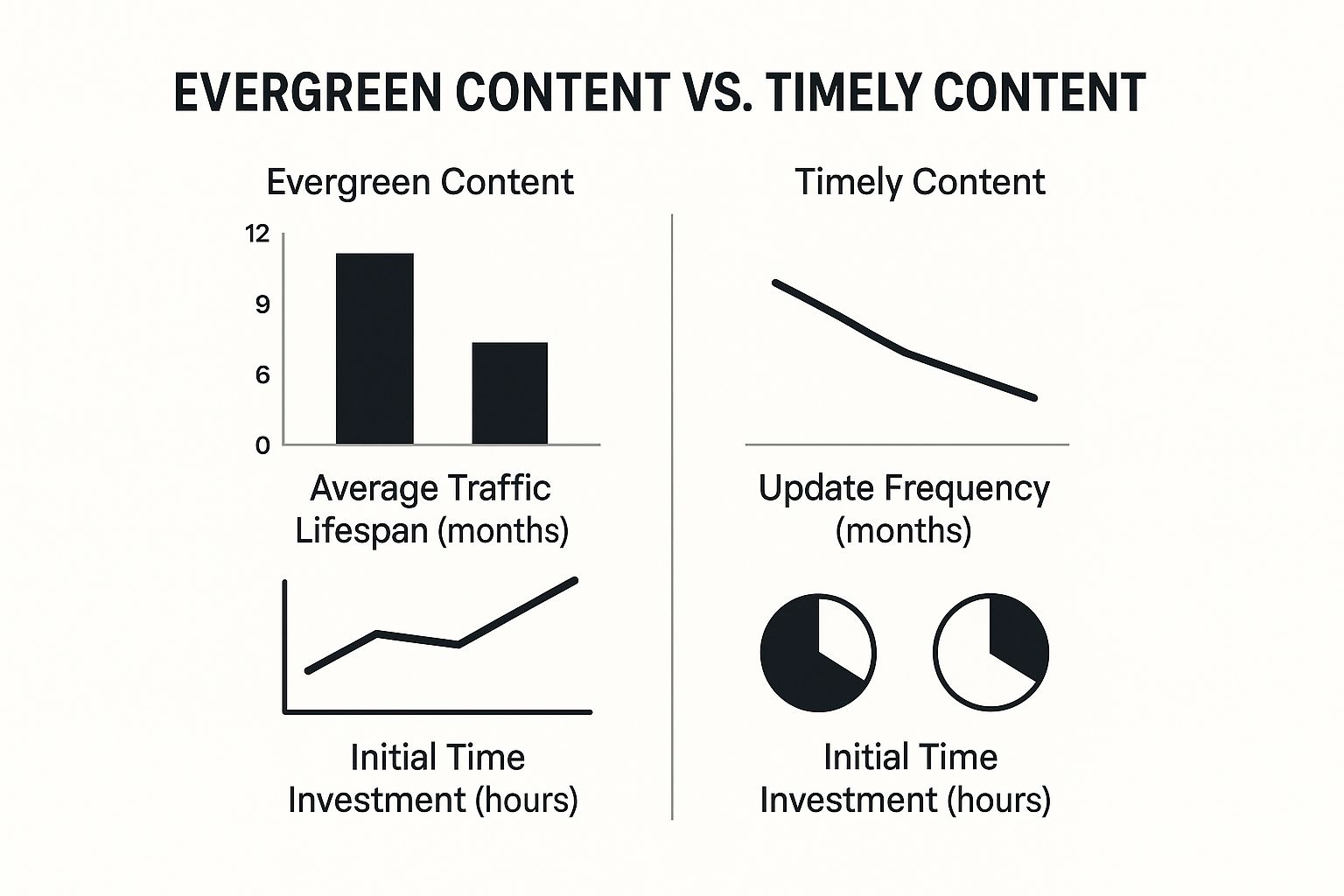Why Evergreen Content Outperforms Everything Else

Content marketing trends are constantly changing. This can make it difficult to maintain a successful online presence. However, evergreen content offers a solution. Evergreen content is designed to remain relevant and valuable long-term.
The Power of Longevity
An evergreen content strategy offers significant advantages. Consider an article on the latest social media trend. It may generate initial interest, but this will likely fade quickly. In contrast, a comprehensive guide on social media marketing fundamentals will continue attracting readers for years. This longevity results in a higher return on investment (ROI). Evergreen content also builds trust and establishes your authority.
Consistent Traffic and Compounding Returns
Evergreen content also drives consistent traffic. While trendy content experiences fluctuating traffic levels, evergreen content provides a steady stream of visitors. This consistency is vital for building a loyal audience. Over time, this consistent traffic leads to compounding returns, attracting more readers, building more backlinks, and improving search engine rankings.
Evergreen content is a cornerstone of long-term marketing strategies. Approximately 70% of marketers consistently invest in content marketing, highlighting the importance of evergreen formats like how-to guides and tutorials. These formats offer compounding returns. The continuing popularity of inbound marketing further emphasizes the value of evergreen content, solidifying its role as a sustainable marketing asset. For more statistics on evergreen content marketing, see: Learn more about evergreen content marketing statistics. By focusing on timeless topics and creating high-quality, comprehensive content, you build a sustainable online presence that delivers long-term results. This enduring value is the true power of evergreen content.
Finding Evergreen Topics Your Audience Actually Wants
Finding the right topics for your evergreen content strategy involves more than just basic keyword research. It requires a deep understanding of your audience's needs and the creation of content that continues to provide value over a long period. It's about uncovering those enduring search terms that address persistent challenges and offer long-lasting solutions.
Keyword Research For Evergreen Content
Begin by conducting keyword research specifically targeted at terms that remain relevant irrespective of current trends. Focus on keywords related to core concepts within your niche. For example, in the fitness industry, keywords like "how to lose weight" or "best exercises for beginners" will likely remain relevant long after trendy diet fads have faded. Understanding diverse content strategies is crucial. You can explore more about general content strategy.
Analyzing Competitive Content
Examine your competitors' evergreen content strategies. Identify any gaps or opportunities they may have overlooked. This can reveal underserved areas within your niche where you can create high-value content. This competitive analysis also offers insights into successful content formats and topics that resonate with your target audience.
Understanding Audience Needs
Transform your audience’s pain points into content ideas. Consider the recurring challenges or questions your audience faces. Addressing these with detailed, helpful content builds value and positions you as a trusted resource. For instance, if you sell software, creating tutorials and FAQs that tackle common user issues is a great way to build trust.
To help illustrate the differences between evergreen and trending content, take a look at the comparison table below:
Evergreen vs. Trending Content Comparison
A comparison of key attributes between evergreen content and time-sensitive content to help readers understand when to use each approach
| Attribute | Evergreen Content | Trending/Timely Content |
|---|---|---|
| Lifespan | Long-term (years) | Short-term (days/weeks) |
| Topic Relevance | Fundamental concepts | Current events/trends |
| Update Frequency | Low | High |
| Initial Time Investment | High | Low |
| SEO Value | Builds authority over time | Captures immediate interest |
| Example | "How to bake a cake" | "Best celebrity Halloween costumes of 2024" |
This table highlights the fundamental difference in lifespan and topic relevance between evergreen and trending content, demonstrating how each serves a unique purpose in a content strategy. Evergreen content, with its long-term value, builds authority over time, while trending content captures immediate interest.

The infographic above visually reinforces the long-term benefits of evergreen content. While it requires a higher initial time investment, it yields a longer traffic lifespan and necessitates less frequent updates compared to timely content. This underscores the efficiency and lasting value of an evergreen approach.
Evaluating Topic Ideas
Before committing significant resources, evaluate your topic ideas based on specific criteria:
- Search Volume: Does the topic maintain consistent search volume over time?
- Competition: Is the level of competition manageable?
- Relevance: Will the topic stay relevant in the foreseeable future?
- Value: Does the topic offer genuine value to your target audience?
By carefully considering these factors, you can focus your evergreen content strategy on topics that deliver consistent, long-term results.
Crafting Content That Stands the Test of Time

Creating evergreen content as a key part of a successful evergreen content strategy involves more than just avoiding information tied to a specific date. It's about developing content that continues to provide value and stay relevant to your audience for years. This means understanding what makes content last and knowing what to avoid.
Comprehensive Topic Coverage and Accessibility
A cornerstone of evergreen content is comprehensive coverage. This involves exploring all facets of a topic thoroughly and in a way that's easy to understand. A solid foundation is essential. Start with a clear introduction, move through logical sections, and finish with a concise summary.
For example, a guide to "social media marketing" shouldn't just cover individual platforms like Facebook or Twitter. It also needs to explore fundamental principles such as audience engagement and developing a content strategy. Explaining complex concepts clearly, using analogies and real-world examples, helps ensure your content remains accessible to a broad audience over time.
Balancing Depth With Clarity
Creating truly evergreen content requires finding the sweet spot between in-depth information and clear, reader-friendly language. Thorough research and detailed information build credibility. However, presenting this information in a digestible format is equally important.
This means using concise language, breaking up large text blocks with headings and bullet points, and incorporating visuals to highlight key takeaways.
Avoiding Content Obsolescence
Actively preventing your content from becoming outdated is crucial for a successful evergreen content strategy. Some topics, like "how to tie a tie," are naturally timeless. Others need careful framing to avoid becoming dated.
When discussing search engine optimization (SEO), concentrate on fundamental principles rather than specific algorithm updates. This approach ensures your content remains relevant even as search engine algorithms change.
Identifying and Avoiding Pitfalls
Several subtle factors can inadvertently date your content. Minimize or avoid references to specific technologies, pop culture trends, or current events. For example, mentioning a particular social media platform that later declines in popularity can quickly make your content seem out of touch.
A "checklist" approach can be valuable. Before publishing, review your content for anything time-sensitive and consider its long-term impact. This proactive approach will help ensure your content truly stands the test of time.
SEO Strategies That Keep Evergreen Content Visible
Maximizing the impact of your evergreen content strategy requires a dedicated SEO approach. This isn't simply about the initial optimization. It's also about maintaining visibility and high rankings through algorithm updates and evolving search trends. This necessitates a multi-faceted strategy encompassing keyword targeting, internal linking, metadata optimization, schema markup, and ongoing performance monitoring.
Strategic Keyword Targeting for Long-Term Visibility
Start by targeting stable keywords with consistent search intent. These keywords represent core concepts within your industry and are less susceptible to fluctuating search trends. For example, instead of focusing on "best SEO tools 2024," which will quickly become outdated, target "best SEO tools for small businesses." This is a query with enduring relevance. This long-term vision ensures your content remains valuable and attracts consistent organic traffic.
Internal Linking to Reinforce Authority
Develop a robust internal linking architecture that connects your evergreen content pieces. This strengthens your site's overall authority by distributing link equity among related pages. Think of it as creating a web of knowledge where each piece supports the others. This interlinking not only improves SEO but also enhances user experience by guiding readers to other valuable resources on your site.
Optimizing Metadata for Sustained Relevance
Metadata, including title tags and meta descriptions, plays a crucial role in attracting clicks from search results. Craft compelling metadata that accurately reflects the content while incorporating your target keywords. Avoid simply stuffing keywords into your metadata. Instead, focus on writing concise, descriptive summaries that entice users to click. Periodically refreshing metadata with variations of your target keywords can enhance visibility and attract a broader audience.
Enhancing SERP Features with Schema Markup
Schema markup, a type of structured data, provides search engines with a clearer understanding of your content. Implementing schema markup, particularly for how-to articles, FAQs, and product reviews, can enhance your SERP features. For instance, schema can help display rich snippets, FAQs, and other interactive elements that improve visibility and click-through rates. This added layer of information helps search engines understand your content's context and relevance.
Monitoring Performance and Adapting to Algorithm Changes
Evergreen content excels at maintaining views long after its initial publication. Unlike time-sensitive articles, evergreen content continues attracting consistent traffic due to its enduring relevance and consistently high search engine rankings. Explore this topic further. Even evergreen content requires monitoring, however. Track keyword rankings, organic traffic, and backlink profiles to identify any declining trends. Set up alerts for algorithm updates and be ready to adapt your content accordingly. This proactive approach ensures your evergreen content remains visible and continues delivering value over time. Tools like Google Analytics, potentially integrated with platforms like EvergreenFeed, can significantly streamline this monitoring process, ensuring your content consistently performs at its best. This strategic approach is key to a truly successful evergreen content strategy.
The Content Maintenance System That Preserves Value
Maintaining a successful evergreen content strategy requires a systematic approach to content maintenance. Even timeless content needs occasional refreshing to maximize its impact and lifespan. This involves efficient content audits, regular refresh schedules, and updating existing content with new information while preserving SEO. Driving traffic is key to SEO, and this article on increasing Shopify sales offers valuable insights.
Implementing Efficient Content Audits
Regular content audits are essential for identifying opportunities for improvement. These audits don't need to be exhaustive. Focus on efficiency by prioritizing your best-performing evergreen content. Look for outdated information, areas where visuals could be enhanced, and opportunities to add new insights.
Developing Systematic Refresh Schedules
Create a systematic refresh schedule based on performance data instead of updating content randomly. Declining traffic or engagement signals the need for a refresh. This data-driven approach focuses your efforts where they're needed most. Tools like Google Analytics, integrated with platforms like EvergreenFeed, can provide the necessary data.
Enhancing Content Without Disrupting SEO
When updating content, prioritize maintaining your current SEO equity. Avoid significant changes to URLs, titles, or keyword targeting. Focus on improving the content itself. Adding new research, updating statistics, and enhancing readability can all be done without negatively impacting your SEO. This preserves search engine rankings while providing fresh, valuable content.
Expanding Into Topic Clusters
High-performing evergreen content often lends itself to expansion into comprehensive topic clusters. This involves creating a series of related content pieces around a central theme. This approach deepens your content coverage, strengthens topical authority, and offers additional value to your audience. For example, a popular blog post on "email marketing" could expand into articles on list building, automation, and metrics.
Maintaining Factual Accuracy and Freshness
As industries evolve, your evergreen content should too. Maintaining factual accuracy is vital for credibility and trustworthiness. Regularly review content for outdated information, updating it with the latest research and insights. This ensures your content remains relevant and authoritative.
Balancing Freshness and Established Authority
Balancing content freshness with established authority is crucial. While updates are necessary, avoid constant rewriting or restructuring. This can dilute authority and confuse your audience. Focus on strategic enhancements that add value without altering the core message or structure.
Example Maintenance Workflow
A simple maintenance workflow could include:
- Quarterly audits: Review top-performing content for updates.
- Performance-based updates: Refresh content showing declining traffic or engagement.
- Annual reviews: Conduct a comprehensive review of all evergreen content.
This structured approach to content maintenance is essential for a successful evergreen content strategy. It ensures your content remains valuable, relevant, and visible, delivering consistent results. The table below provides a practical maintenance schedule:
The following table, "Evergreen Content Maintenance Schedule," provides a practical framework demonstrating when and how to audit, update, and refresh different types of evergreen content.
| Content Type | Audit Frequency | Update Indicators | Refresh Actions |
|---|---|---|---|
| How-to guides | Quarterly | Decreased traffic, outdated information | Update screenshots, revise instructions, add new tips |
| Ultimate guides | Bi-annually | Declining engagement, new industry developments | Add new sections, update data, refresh visuals |
| Listicles | Quarterly | Decreased shares, new relevant items | Add new items, remove outdated items, update formatting |
| FAQs | Annually | New product features, changes in customer questions | Add new questions, update answers, improve readability |
This table provides a framework for maintaining different types of evergreen content, ensuring their ongoing value and effectiveness. By implementing a structured maintenance system, you maximize the long-term benefits of your evergreen content strategy.
Distribution Tactics That Give Evergreen Content New Life

Creating high-quality evergreen content is only the first step. A successful content strategy also requires a robust distribution plan. This ensures your content continues to work for you long after its initial publication date, consistently reaching new audiences and maximizing its overall impact.
Cyclical Promotion Schedules For Consistent Visibility
A cyclical promotion schedule systematically reintroduces your evergreen content to new audiences. This prevents valuable resources from being forgotten and ensures they continue generating traffic over time. Just as fashion trends reappear seasonally, your evergreen content can be regularly re-promoted.
This might involve sharing older blog posts on social media, highlighting key takeaways in email newsletters, or featuring them in relevant online communities. Consistent visibility keeps your content relevant and top-of-mind for your target audience.
Leveraging Email Nurturing Sequences
Email nurturing sequences offer a powerful way to deliver evergreen content at the perfect moment in the customer journey. By segmenting your audience and tailoring content to their specific needs, you provide relevant information that guides them through the sales funnel.
For instance, a series of emails addressing common customer pain points and linking back to relevant blog posts or FAQs can be highly effective. This targeted approach provides value and builds trust with potential customers.
Efficient Recurring Promotion With Social Scheduling Tools
Social media platforms are ideal for distributing evergreen content. However, manual posting can be time-consuming. Social scheduling tools, like EvergreenFeed, automate this process, allowing for efficient recurring promotion.
EvergreenFeed simplifies scheduling by enabling content categorization and pre-determined posting schedules. This ensures consistent social media activity and maximizes your evergreen content's reach without constant manual effort.
Repurposing Evergreen Content Across Multiple Formats
Repurposing existing evergreen content into various formats expands its reach and caters to different audience preferences. A blog post can be transformed into an infographic, a video, or even a podcast episode.
This multi-format approach allows you to connect with audiences who prefer different content consumption methods, maximizing the value of your existing content and boosting engagement.
Building Strategic Partnerships To Extend Content Reach
Strategic partnerships can significantly amplify your content distribution efforts. Collaborating with complementary businesses or influencers in your industry allows you to tap into their established audiences.
This cross-promotion introduces your content to potential new customers and builds valuable relationships within your niche.
Measuring Distribution Effectiveness With Multi-Touch Attribution
Understanding the true effectiveness of your distribution requires tracking content performance across multiple channels. Multi-touch attribution models provide a comprehensive view of the customer journey. They identify which channels and content pieces contribute to conversions.
This data-driven approach enables you to optimize your distribution strategy over time, focusing on the most effective channels. By analyzing user engagement across various touchpoints, you can refine your approach and maximize its impact. This ensures your valuable evergreen content continues attracting new audiences and contributes to your long-term marketing success.
Measuring Evergreen Impact Beyond Standard Metrics
Measuring the success of your evergreen content strategy requires a more nuanced approach than simply tracking immediate results. While metrics like page views and social shares offer valuable insights, they don't fully capture the long-term impact of evergreen content. To truly understand its value, you need to look beyond these standard metrics and consider the cumulative effects and long-tail benefits.
Tracking Cumulative Performance Over Extended Timeframes
Unlike trending topics, evergreen content is designed to remain relevant and valuable over extended periods, often spanning months or even years. Therefore, evaluating its performance requires tracking cumulative traffic, lead generation, and conversions over these longer timeframes. This provides a much more accurate picture of the true return on investment (ROI). For instance, a blog post providing a comprehensive guide on "how to bake a cake" could consistently attract traffic for years, accumulating a substantial number of views and conversions that short-term metrics wouldn't reflect.
Establishing Proper Attribution for Long-Tail Conversions
It's important to recognize that conversions often occur long after the initial interaction with the content. A reader might absorb your insightful blog post today, but not make a purchase until months later. Accurately attributing these long-tail conversions to the original content piece is vital for understanding its true value. Implementing robust tracking mechanisms like UTM parameters and cookie tracking can connect delayed conversions back to the initial touchpoint, revealing the real impact of your evergreen content on your bottom line.
Calculating the Lifetime Value of Evergreen Content
Evergreen content, by its very nature, continues to generate value throughout its entire lifespan. This allows you to calculate its lifetime value, which represents the total value generated by a single piece of content over time. This metric is particularly useful for comparing the ROI of evergreen content against time-sensitive content. You'll likely discover that the initial, often higher, investment in crafting high-quality evergreen content yields a significantly higher lifetime value.
Benchmarking and Comparing Evergreen Content Performance
Establishing benchmarks is essential for comparing evergreen content performance against other content types. This not only helps set realistic performance expectations, but also allows you to assess the effectiveness of your overall content strategy. Comparing metrics like average session duration, bounce rate, and conversion rate between evergreen and trending content can effectively highlight the long-term benefits of a sustainable evergreen approach.
Communicating Value to Stakeholders
Stakeholders often prioritize short-term metrics. Therefore, clearly communicating the long-term value of evergreen content is crucial. Developing reporting structures and dashboard templates that showcase cumulative performance, long-tail conversions, and lifetime value can help stakeholders grasp the compounding returns that evergreen content generates, even if immediate results appear modest.
Practical Dashboard Templates and Reporting Structures
Consider these practical dashboard templates and reporting structures to effectively communicate the value of your evergreen content strategy:
- Cumulative Traffic Dashboard: Track total views, unique visitors, and average session duration over extended periods.
- Long-Tail Conversion Report: Analyze conversions attributed to evergreen content over time, highlighting its long-term impact.
- Lifetime Value Calculator: Estimate the total value generated by individual evergreen content pieces over their lifespan.
- Comparative Performance Report: Compare key metrics between evergreen and time-sensitive content, showcasing the advantages of a sustainable evergreen approach.
These tools will help demonstrate the long-term benefits of an evergreen content strategy to stakeholders. By showcasing cumulative growth, long-tail impact, and lifetime value, you can effectively highlight the substantial ROI of evergreen content. Ready to automate your social media posting and maximize the reach of your evergreen content? Sign up for a free EvergreenFeed account today and start experiencing the benefits of a consistent and engaging social media presence.




